Plant lovers know the joy of adding green to their homes. Dracaena plants are a favorite for indoor gardening. They make any room look lush and vibrant with little work.
Struggling with houseplants? Dracaena might be your answer. These plants are tough and beautiful. They help beginners and experts alike enjoy greenery indoors.
Dracaena care is more than just keeping a plant alive. It’s about connecting your home to nature’s strength. This guide will teach you how to prevent brown leaves and water just right.
Whether you’re new to plants or have experience, dracaena care is key. It will change your home and help you love these amazing plants even more.
Understanding Dracaena Varieties
Dracaena varieties open up a world of indoor plants that can change your home. These plants come in many forms, each with its own special traits. They fit perfectly into different home settings.
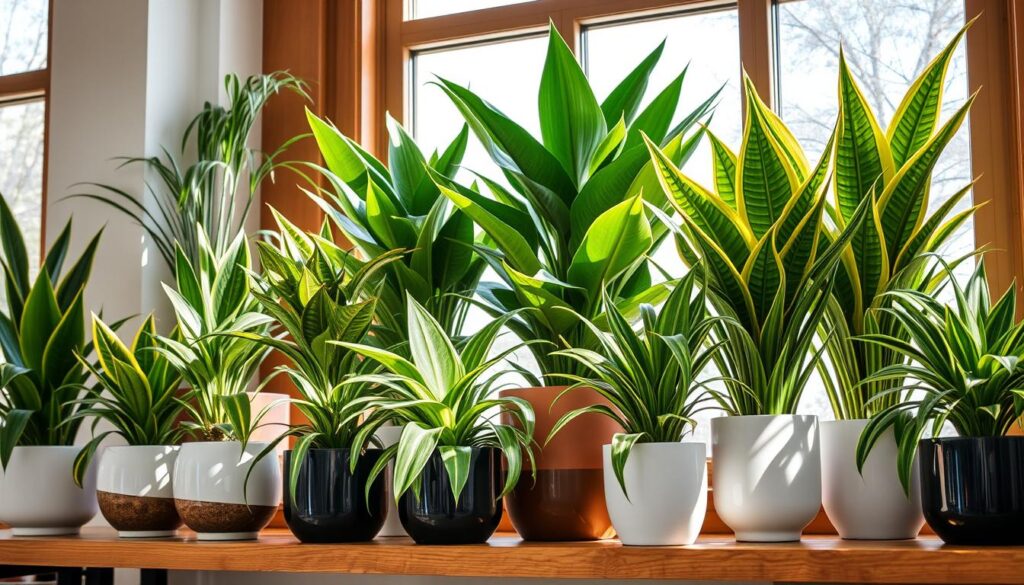
Exploring dracaena varieties reveals a range of beautiful species. They match almost any home decor style. Each variety adds its own charm and beauty to your space.
Popular Dracaena Species
- Dracaena marginata (Dragon Tree)
- Dracaena fragrans (Corn Plant)
- Dracaena sanderiana (Lucky Bamboo)
- Dracaena reflexa (Song of India)
Unique Features of Different Varieties
| Species | Leaf Color | Height | Light Requirement |
|---|---|---|---|
| Dragon Tree | Red-edged green | 6-8 feet | Bright indirect light |
| Corn Plant | Dark green | 4-6 feet | Low to medium light |
| Lucky Bamboo | Bright green | 1-3 feet | Low indirect light |
Choosing the Right Dracaena for Your Space
Choosing the right dracaena depends on several things. Think about your space, light, and what you like. Some need little light, while others want lots of indirect sun.
Look at your room’s size, humidity, and temperature. Small spaces might do well with Lucky Bamboo. Bigger rooms can handle the tall Dragon Trees.
Ideal Growing Conditions for Dracaena Plants
Creating the perfect environment for your dracaena plant is crucial to its health and growth. These versatile houseplants thrive when you understand their specific care requirements. By paying attention to their unique needs, you can help your dracaena plant flourish and become a stunning addition to your home.
Light Requirements for Optimal Growth
Dracaena plants are known for their adaptability to indoor lighting conditions. They prefer bright, indirect light but can tolerate lower light environments. Direct sunlight can scorch their delicate leaves, so placement is key in dracaena care.
- Ideal light: Bright, filtered light
- Avoid: Direct afternoon sunlight
- Low light tolerance: Moderate to low light conditions
Temperature and Humidity Preferences
Your dracaena plant enjoys consistent temperatures and moderate humidity. These tropical plants thrive in environments that mimic their native habitat.
| Condition | Ideal Range | Recommendations |
|---|---|---|
| Temperature | 60-75°F | Avoid cold drafts and sudden temperature changes |
| Humidity | 40-60% | Use a humidity tray or occasional misting |
Best Locations in Your Home
Selecting the right spot for your dracaena plant can make a significant difference in its overall health. Look for areas with consistent temperatures and indirect light.
- Living room corners
- Near east or north-facing windows
- Away from air conditioning vents
- Office spaces with filtered light
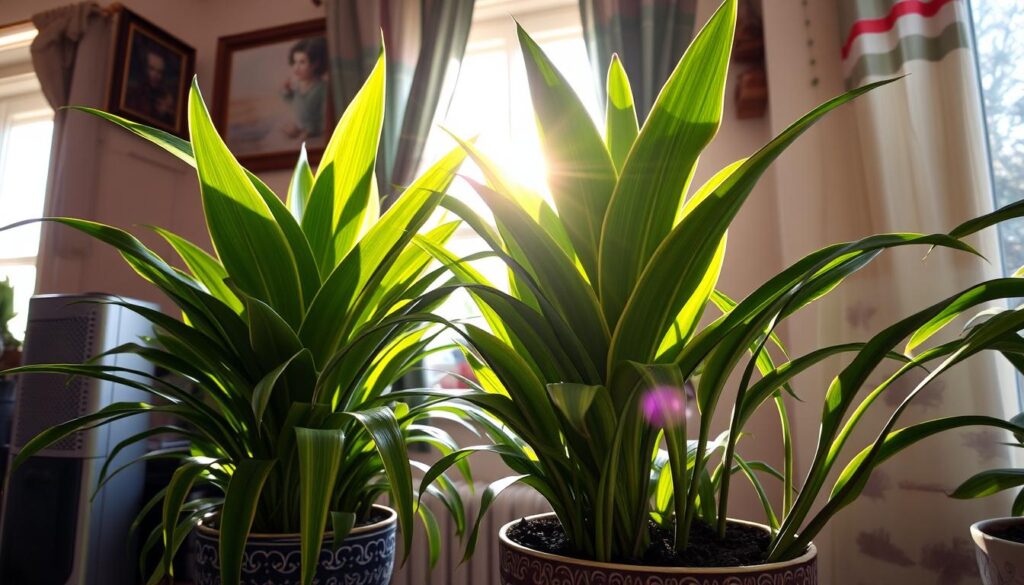
By understanding these key growing conditions, you can provide exceptional dracaena care and enjoy a thriving, vibrant plant in your living space. Remember that each dracaena variety might have slight variations in its specific requirements.
Watering Your Dracaena: Best Practices
Learning how to water your dracaena is key to keeping it healthy. The right amount of water can make a big difference. Knowing what your dracaena needs will make you a great plant parent.
Proper Watering Techniques
Starting with the right water amount is the first step in caring for your dracaena. These plants like moist soil but don’t like wet feet. Here are some tips for watering:
- Check soil moisture by inserting your finger 2 inches deep
- Water when the top layer of soil feels dry
- Use room temperature water
- Ensure proper drainage in plant containers
Identifying Watering Stress Signals
Knowing the signs of water stress is important. It helps avoid harming your dracaena. Different signs show if you’re giving too much or too little water.
| Overwatering Signs | Underwatering Signs |
|---|---|
| Yellowing leaves | Crispy brown leaf edges |
| Soft, mushy stems | Drooping or wilting leaves |
| Root rot | Dry, compacted soil |
Seasonal Watering Adjustments
Dracaena needs change with the seasons. In spring and summer, they need more water. In fall and winter, they need less.
- Spring/Summer: Water every 7-10 days
- Fall/Winter: Water every 10-14 days
By following these tips, your dracaena will stay healthy and beautiful all year.
Soil and Fertilizer Requirements
To create the perfect home for your dracaena, you need to know about its soil and nutrition needs. The right soil is key for your plant’s growth and health.
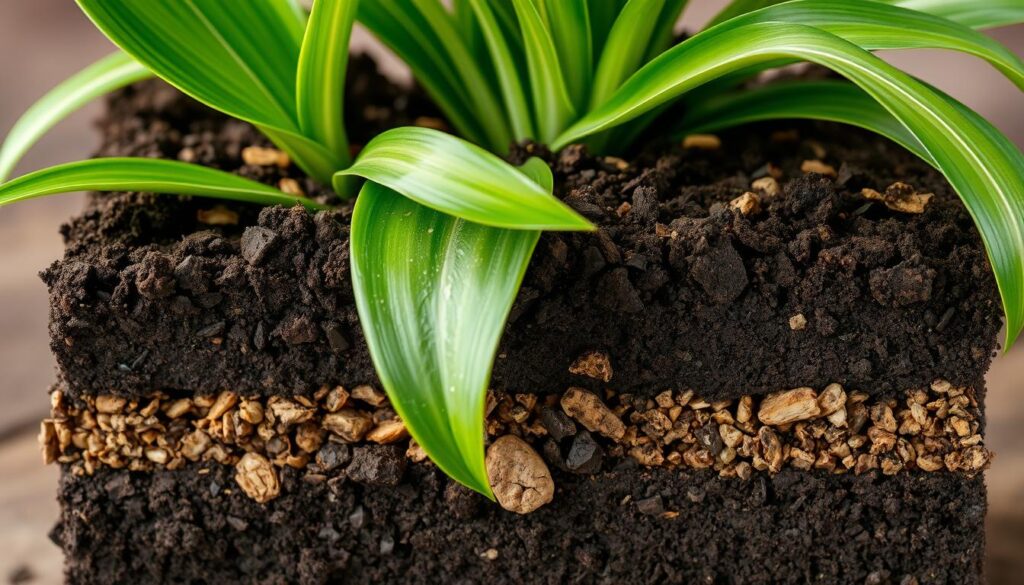
Choosing the Right Potting Mix
Start by picking a potting mix that drains well and holds nutrients. Your dracaena needs a mix that’s balanced. It should include:
- Standard potting soil
- Perlite for aeration
- Peat moss for moisture control
- Organic compost for nutrients
Fertilizing Schedule and Techniques
Fertilizing is crucial for your dracaena’s growth. Use a balanced, water-soluble fertilizer in spring and summer.
| Season | Fertilizer Frequency | Nutrient Concentration |
|---|---|---|
| Spring/Summer | Every 4-6 weeks | Half-strength liquid fertilizer |
| Fall/Winter | Reduce to every 8-10 weeks | Minimal to no fertilization |
Repotting Your Dracaena
Repot your dracaena every 2-3 years. This refreshes the soil and gives it room to grow. Choose a pot that’s 1-2 inches bigger than the current one, with good drainage holes.
With the right soil and fertilization, your dracaena will stay healthy and vibrant for many years.
Pruning and Shaping Your Dracaena
Dracaena care means cutting back the plant to keep it healthy and looking good. With the right care, your dracaena can become a beautiful green centerpiece in your home.

Timing Your Pruning Session
The best time to prune your dracaena is during its active growing season, which is spring and summer. Look for these signs that your plant needs a trim:
- Leggy or elongated stems
- Dead or yellowing leaves
- Overgrown plant disrupting room aesthetics
- Desire to control plant size
Essential Pruning Techniques
When you prune your dracaena, use clean, sharp shears to avoid damage and disease. Cut stems at a 45-degree angle just above a leaf node. This helps new growth.
| Pruning Tool | Recommended Use |
|---|---|
| Sterilized Pruning Shears | Primary cutting tool |
| Rubbing Alcohol | Sterilizing tools between cuts |
| Clean Cloth | Wiping cut surfaces |
Encouraging Bushier Growth
To make your dracaena fuller, try pinching. Gently remove the growing tip of stems to encourage branching. This method helps your plant grow more compact and lush over time.
Propagating Dracaena Plants
It’s easy to grow more dracaena plants. You can make new ones from the ones you already have. This is a cheap way to add more plants to your home. Here’s how to do it.

Propagating dracaena plants is a fun way to increase your collection. You can use stem cutting or top cutting techniques.
Stem Cutting Method
The stem cutting method is a good way to make more dracaena plants. Just follow these steps:
- Choose a healthy stem with lots of leaves
- Cut a 4-6 inch piece with sharp pruning shears
- Take off the bottom leaves, leaving 2-3 at the top
- Put the cutting in water or soil
Top Cutting Technique
Top cutting is great for tall or leggy dracaena plants. It makes the plant look better and creates a new one. This works best if the plant has a clear stem and leaves.
- Cut off the top 4-5 inches
- Make sure the cutting has healthy leaves
- Root the cutting in water or soil
- Keep the original plant for more growth later
Caring for Newly Propagated Plants
New dracaena plants need special care to grow well. Keep the soil moist and give them indirect light.
| Propagation Factor | Recommended Conditions |
|---|---|
| Light | Bright, indirect sunlight |
| Temperature | 65-75°F (18-24°C) |
| Humidity | 50-60% humidity |
| Watering | Soil should be moist but not too wet |
With care and patience, your new dracaena plant will grow strong. It will soon be a healthy part of your indoor garden.
Common Dracaena Pests and Diseases
Keeping your dracaena plant healthy is important. You need to watch out for pests and diseases. These can harm your plant if not treated.
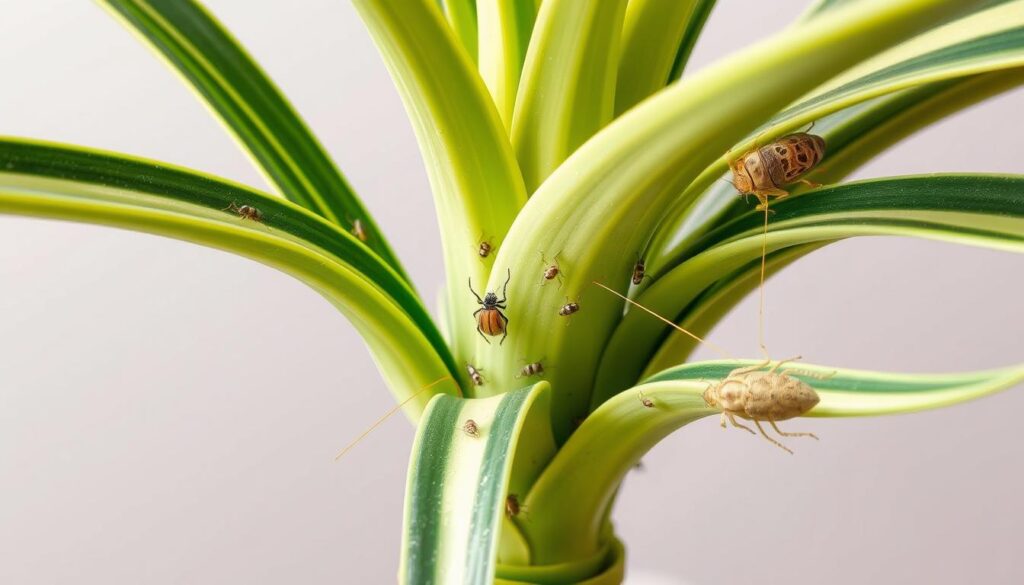
Identifying Common Pests
Dracaena diseases often start with tiny pests. These pests can cause a lot of damage. Here are some common ones to watch for:
- Spider Mites: Tiny web-like structures on leaf undersides
- Mealybugs: White, cottony clusters near leaf joints
- Scale Insects: Small, hard bumps on stems and leaves
Recognizing Disease Symptoms
Spotting diseases early can help your plant. Look out for these signs:
- Yellowing leaves: This could mean root rot or a lack of nutrients.
- Brown leaf tips: This is a sign of too little water.
- Soft, mushy stems: This could be a sign of a bacterial or fungal infection.
Natural and Chemical Treatment Options
Good care for your dracaena includes managing pests and diseases. Here are some ways to do it:
- Natural Remedies:
- Neem oil spray
- Insecticidal soap
- Quarantine new plants
- Chemical Treatments:
- Systemic insecticides
- Fungicide solutions
- Specialized plant treatments
Regular checks and prevention are crucial. This way, you can keep your dracaena plant healthy. Being proactive helps protect your plant from harm.
Troubleshooting Common Dracaena Problems
Keeping a dracaena plant healthy means knowing how to fix common problems. You need to watch your plant closely and act fast if you see any odd changes. This helps your plant stay healthy and strong.
Yellowing or Browning Leaves
Seeing yellow or brown leaves can worry any dracaena owner. These signs usually mean there’s a problem with how you care for your plant. Common issues include:
- Improper watering (over or under)
- Inadequate light exposure
- Nutrient deficiencies
- Temperature stress
To fix yellow leaves, check your watering and make sure your dracaena gets enough light. Move it if it’s too close to direct sun or too dark.
Leaf Drop
Dracaena plants dropping leaves can be scary, but it’s not always a big deal. Leaves can fall due to age, changes in the environment, or stress. Look out for these reasons:
- Sudden temperature changes
- Drafts or cold air
- Big changes in humidity
- Pests
Tip: Keep your dracaena in a steady environment and slowly get it used to new conditions to reduce leaf drop.
Stunted Growth
Stunted growth means your dracaena might not be happy with its current home. Reasons include:
- Root-bound container
- Poor soil quality
- Not enough nutrients
- Too little light
Regular care for your dracaena means repotting it, using the right fertilizers, and making sure it has the best growing conditions. Fixing these issues helps your plant grow well and stay healthy.
Dracaena as Air Purifiers
Your dracaena indoor plant does more than just look beautiful. These plants are secret weapons against indoor air pollution. NASA’s Clean Air Study showed that dracaena plants are powerful natural air purifiers. They make your living space healthier.
NASA Clean Air Study Revelations
Scientists found that certain dracaena plant varieties can remove harmful toxins from indoor air. The study showed their ability to filter out dangerous chemicals found in homes and offices.
Toxins Eliminated by Dracaenas
Dracaena indoor plants are great at removing specific air pollutants:
- Formaldehyde from furniture and carpets
- Benzene from paint and synthetic materials
- Trichloroethylene from cleaning products
Strategic Placement for Maximum Air Purification
To get the most out of your dracaena plant’s air-cleaning power, try these placement tips:
| Room Type | Recommended Plants | Air Purification Effectiveness |
|---|---|---|
| Living Room | 2-3 Dracaena marginata | High |
| Bedroom | 1-2 Dracaena fragrans | Moderate |
| Home Office | 1-2 Dracaena reflexa | High |
Your dracaena plant is more than just a decoration. It’s a natural air purification system working quietly to improve your indoor air. By placing these plants strategically, you can greatly reduce harmful toxins and breathe easier at home.
Decorating with Dracaena Plants
Dracaena indoor plants are perfect for home decor. They add elegance with their unique shapes and lush leaves. They can make any room look modern or tropical.
Complementing Different Interior Styles
Different dracaena varieties fit different styles:
- Minimalist Spaces: Use tall, sleek Dracaena marginata with its slender stems
- Tropical Rooms: Select broad-leafed Dracaena fragrans for lush greenery
- Modern Interiors: Choose structured Dracaena reflexa for clean lines
Creative Display Ideas
Here are some ways to show off your dracaena plants:
- Create vertical garden corners
- Use as natural room dividers
- Place near windows for dramatic silhouettes
- Group different dracaena varieties for visual interest
Pairing with Other Plants
Pair dracaena varieties with other plants for a stunning look. Mix different heights, textures, and leaf shapes. This creates a lively green display in any room.
Long-Term Care and Maintenance Tips
Learning to care for dracaena plants takes time and regular effort. With the right care, your dracaena can live for many years. Knowing what these plants need helps you create the best environment for them to grow and stay green.
Seasonal Care Adjustments
Changing how you care for your dracaena with the seasons is key. In winter, water less often and fertilize less. In summer, water more and mist to keep the air moist. Pay attention to how your plant grows and adjust your care as needed.
Longevity and Growth Expectations
Most dracaena plants can live 10-15 years with good care. They grow about 4-6 inches a year indoors. As they get older, they develop unique shapes. Regular pruning keeps them looking good and prevents them from getting too big.
Rejuvenating Mature Dracaenas
Older dracaenas can get leggy or lose leaves. To perk them up, trim back tall stems to encourage new growth. Repotting every 2-3 years with fresh soil gives them the nutrients they need. With the right care, your dracaena will stay healthy and vibrant for years.
FAQ
What are the most common varieties of dracaena plants?
Popular dracaena types include the Dragon Tree (Dracaena marginata) and the Corn Plant (Dracaena fragrans). There’s also the Lucky Bamboo (Dracaena sanderiana) and Janet Craig (Dracaena deremensis). Each has its own look, from long, thin leaves to wider, more tropical ones.
How often should I water my dracaena plant?
Water your dracaena when the top 1-2 inches of soil feel dry. This usually means watering every 7-10 days. But it can change based on humidity, temperature, and the season. Water less in winter and make sure the soil drains well to avoid root rot.
What type of light do dracaena plants prefer?
Dracaenas love bright, indirect light. They can handle lower light but grow slower. Avoid direct sunlight to prevent leaf scorch. A spot near a north or east window is perfect for most varieties.
How do I propagate a dracaena plant?
You can grow new dracaenas from stem or top cuttings. For stem cuttings, cut a 4-6 inch section, remove lower leaves, and place it in water or soil. Top cuttings involve cutting the top and letting it root, which can also make a leggy plant fuller.
What are common pest problems for dracaena plants?
Dracaenas often face spider mites, mealybugs, and scale insects. Look for webbing, white cottony masses, or small brown bumps. Regularly check your plant and treat any infestations with neem oil, insecticidal soap, or alcohol on leaves.
Why are the leaves of my dracaena turning yellow?
Yellow leaves can mean overwatering, underwatering, poor drainage, nutrient lack, or not enough light. Check your watering, drainage, and light. Adjust as needed to help your plant.
Can dracaena plants help purify indoor air?
Yes! The NASA Clean Air Study shows dracaenas are great at removing pollutants like formaldehyde and benzene. They’re a natural way to clean the air in your home or office.
What type of soil is best for dracaena plants?
Use a potting mix with peat moss, perlite, and standard soil. It should hold moisture but drain excess water quickly. A 2:1:1 mix of potting soil, peat moss, and perlite works well for most varieties.
How do I prune a dracaena plant?
Prune to remove dead leaves, control size, or encourage bushy growth. Use sharp shears and cut above a leaf node. For tall plants, cut the main stem to promote branching and a fuller look.
Do dracaena plants require high humidity?
Dracaenas like moderate humidity but can handle average indoor levels. If it’s very dry, mist the plant, use a humidity tray, or a humidifier to keep it moist.
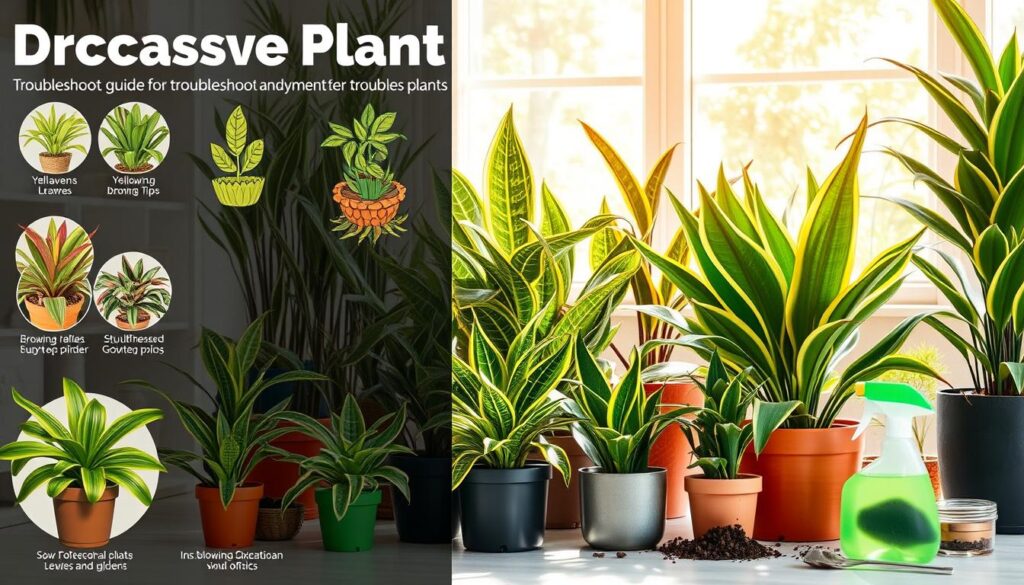



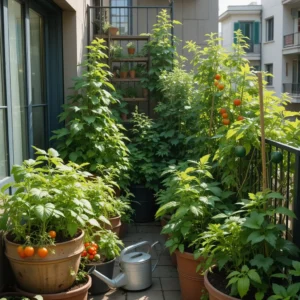
One thought on “Plant Deep Within Unlock the Secret to Vibrant Greenery”